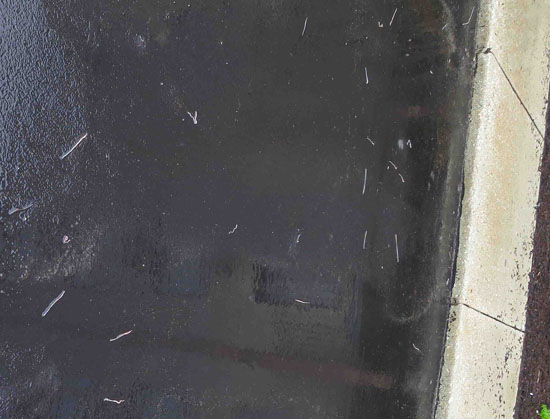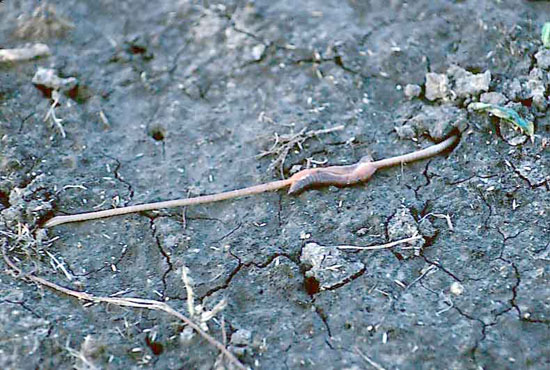Issue 1, April 22, 2013
Why Did the Worm Cross the Street?
Large numbers of earthworms have become obvious on sidewalks and streets with the heavy rains this week. Although it is well known that earthworms leave their burrows during heavy rains, we are unsure why they do it.

Colloquially, it is assumed that earthworms come to the surface because they are drowning. This is what I was told as a child, but even then I figured out that was not the case. When I was about ten years old, I noticed that the same earthworms were still moving around after being in a mud puddle for several hours on a cloudy day. I deduced that they should have drowned well before that much time elapsed. As I remember, my parents' response to my research findings was "Oh, they must have come up for some other reason." My interest in science at even a young age was surely a repeated burden for my parents. They felt better about it when I grew up and used my interest in science to become gainfully employed.
Earthworms breathe through their skin; they do not have lungs like spiders and us or spiracles like insects. As long as there is a reasonably high level of oxygen in the air or water and their skin stays moist, they do not want for oxygen. However, they are sensitive to increased levels of carbon dioxide and will move away from it. One possible reason for why earthworms leave their burrows during heavy rains is that the carbon dioxide that they expel does not dissipate very well in their flooded burrows.
Related to their avoidance of carbon dioxide, they are also repelled by low pH water. Increased levels of carbon dioxide in water causes it to be more acidic, having a lower pH. Rainwater by its nature is acidic; it becomes acidic during its formation. We have all heard of acid rain, which in reality is repetitive. The term acid rain refers to it becoming even more acidic due to increased carbon dioxide, sulfur oxides, and other low pH pollutants produced by industrial facilities. The rain that falls on my rural property south of Urbana ranges from a pH of 5.0 to 5.5. My well water has a pH range of 7.0-7.2, which is neutral to very slightly alkaline. It is likely that the water in the soil has a similar pH. It is thought that an influx of lower pH rainwater into their burrows causes the earthworms to leave.
Still another theory on why earthworms leave their burrows during rains is to migrate and reproduce. The assumption is that standing water and saturated soil is like an interstate expressway for earthworms, allowing them to move more freely and faster than through the soil or over its drier surface. Those that find themselves in mud puddles on streets and sidewalks are marooned and doomed to death by ultraviolet light. A few hours of exposure to ultraviolet light will kill earthworms as will their skin drying out.

Earthworms mating
Although all of the above except for drowning are probably factors in earthworms coming to the surface during rains, I put more credence in the migration and reproduction hypothesis. If the other factors were the driving influences, large numbers of juvenile worms should also be present, but the vast majority appears to be adult red worms with occasional adult nightcrawlers. When worms are brought to the surface with electricity, worm-grunting, or chemicals, many more worms are present. It is obvious that only a small percentage of the adult red worms are emerging during heavy rains. Perhaps this represents the small percentage of the population with the colonial spirit. It appears somewhat similar to the small percentage of the world's people with a colonial spirit that immigrated to this continent and became our ancestors.
In addition to worms crawling across flooded sidewalks, we have also had reports of holes in the ground the size that would be caused by jabbing a pen into the ground. These one-quarter inch diameter holes are likely those of nightcrawlers. The adults of these large earthworms emerge at night to mate. Although the surface holes made by earthworms commonly have a pile of castings, worm feces, next to them, frequently castings are not present.
Earthworms become active at soil temperatures around 39 degrees F. Insects generally become active within a couple of degrees of 50 degrees F, depending on the insect species. Only in southern Illinois have soil temperatures risen to 50 degrees F, although they are close to that in central Illinois. Although crayfish become active at temperatures below 50 degrees F, they make much larger holes. About the only creatures active at this time to make these holes are earthworms.
Nightcrawlers are hermaphrodites, having both male and female sex organs. They do not mate with themselves but emerge onto the soil surface at night during or after a rain to mate. Typically, members of a pair will stretch out from their respective burrows to meet on the soil surface between them. Complimentary sexual organs contact each other and mating occurs within a protective coating of slime. Each worm keeps its widened posterior end in the burrow as an anchor so that it can quickly retract into the burrow if disturbed. I have spent many spring evenings after dark as a child to teenager collecting nightcrawlers after rains in the spring using a red cellophane covered flashlight to locate the worms. They are very sensitive to white light and vibrations so one has to walk carefully when nightcrawling for fishing bait.
After mating, a cocoon is produced by the clitellum, the smooth area about one-third of the body back from the head end of the worm. As it passes down the worm, eggs are deposited into the cocoon followed by sperm exuded from the spermatheca or sac that received the sperm during mating. Once passing over the head end of the worm, it closes into a lemon-shaped cocoon. The cocoon is deposited in the soil where the fertilized eggs hatch into juvenile worms that leave to make a living on their own. It takes 60 to 90 days for an earthworm to mature sexually and about one year to reach full size. Most earthworm species live for four to eight years although most individuals probably don't survive more than one to two years. (Phil Nixon)